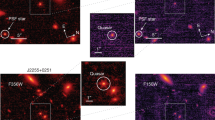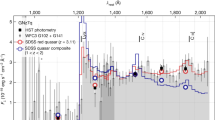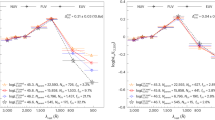Abstract
QUASARS are distant, luminous objects generally thought to be powered by the accretion of gas onto a supermassive black hole1; their spectra are characterized by broad emission lines originating from a dense region close to the central energy source1. The best-studied spectral region in low-redshift quasars is near the Hβ line at 4,861 Å (in the quasar rest frame) where there are also lines arising from singly ionized iron and doubly ionized oxygen. New technology has enabled us to detect strong iron emission in the spectra of the high-redshift (z > 3) quasars Q0014 + 813 and Q0663 + 680, in which these lines are redshifted to the near-infrared. The strength of this emission suggests an iron abundance (relative to hydrogen) higher than in the solar neighbourhood. This high iron abundance supports the view that quasars are located in the centres of massive galaxies. If type Ia supernovae are responsible for the iron enrichment2, significant star formation must have taken place in the host galaxies at least one billion years earlier, providing a constraint on the age of the Universe at that redshift.
This is a preview of subscription content, access via your institution
Access options
Subscribe to this journal
Receive 51 print issues and online access
$199.00 per year
only $3.90 per issue
Buy this article
- Purchase on SpringerLink
- Instant access to full article PDF
Prices may be subject to local taxes which are calculated during checkout
Similar content being viewed by others
References
Osterbrock, D. E. & Mathews, W. G. A. Rev. Astr. Astrophys. 24, 171–203 (1986).
Matteucci, F. & Greggio, L. Astr. Astrophys. 154, 279–287 (1986).
Wampler, E. J. & Oke, J. B. Astrophys. J. 148, 695–704 (1967).
Sargent, W. L. W. Astrophys. J. 152, L31–L34 (1968).
Osterbrock, D. E. Astrophys. J. 215, 733–745 (1977).
Phillips, M. M. Astrophys. J. Suppl. Ser. 38, 187–203 (1978).
Bergeron, J. & Kunth, D. Mon. Not. R. astr. Soc. 207, 263–286 (1984).
Boroson, T. A. & Green, R. F. Astrophys. J. Suppl. Ser. 80, 109–135 (1992).
Collin-Souffrin, S. et al. Astr. Astrophys. 166, 27–35 (1986).
Lipari, S., Macchetto, F. D. & Golombeck, D. Astrophys. J. 366, L65–L67 (1991).
Lawrence, A. et al. Mon. Not. R. astr. Soc. 235, 261–268 (1988).
Bergeron, J. & Kunth, D. Astr. Astrophys 85, L11–L14 (1980).
Boksenberg, A. et al. Mon. Not. R. astr. Soc. 178, 451–166 (1977).
Krolik, J. H. & Kallman, T. R. Astrophys. J. 324, 714–720 (1988).
Netzer, H. & Wills, B. J. Astrophys. J. 275, 445–460 (1983).
Hill, G. J., Thompson, K. L. & Elston, R. Astrophys. J. 414, L1–L4 (1993).
Lipari, S., Terlevich, R. & Macchetto, F. Astrophys. J. 406, L451–L456 (1993).
Penston, M. V. Mon. Not. R. astr. Soc. 229, 1P–5P (1987).
Miley, G. K. & Miller, J. S. Astrophys. J. 228, L55–L58 (1979).
Steiner, J. E. Astrophys, J. 250, 469–477 (1981).
Boroson, T. A. & Oke, J. B. Astrophys. J. 281, 535–544 (1984).
Kühr, H. et al. Astr. J. 86, 854–863 (1981).
Pauliny-Toth, I. I. K. et al. Astr. J. 83, 451–474 (1978).
Carswell, R. F. et al. Astrophys. J. 381, L5–L8 (1991).
Biermann, P. L. et al. Astr. Astrophys. Suppl. Ser. 96, 339–349 (1992).
Wilkes, B. J., Elvis, M. & McHardy, I. Astrophys. J. 321, L23–L27 (1987).
Boroson, T. A. Astrophys. J. 343, L9–L12 (1989).
Kühr, H. et al. Astrophys. J. 284, L5–L8 (1984).
Wills, B. J., Nezter, H. & Wills, D. Astrophys. J. 288, 94–116 (1985).
Wheeler, J. C. Sneden, C. & Truran, J. W. Ann. Rev. Astr. Astrophys. 27, 279–349 (1989).
Iben, I. Jr. & Tutukov, A. V. Astrophys. J. Suppl. Ser. 54, 335–372 (1984).
Hamann, F. & Ferland, G. Astrophys. J. 391, L53–L57 (1992).
Hamann, F. & Ferland, G. Astrophys. J. 418, 11–27 (1993).
Author information
Authors and Affiliations
Rights and permissions
About this article
Cite this article
Elston, R., Thompson, K. & Hill, G. Detection of strong iron emission from quasars at redshift z > 3. Nature 367, 250–251 (1994). https://doi.org/10.1038/367250a0
Received:
Accepted:
Issue date:
DOI: https://doi.org/10.1038/367250a0
This article is cited by
-
Detecting the intrinsic Baldwin Effect of the optical FeII complex in luminous Seyfert 1 galaxy fairall 9
Science China Physics, Mechanics and Astronomy (2011)
-
Iron whiskers in supernova SN 1987A
Astrophysics and Space Science (1995)



